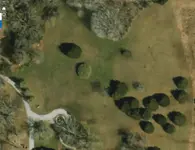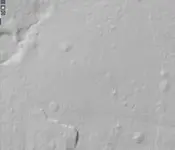From my admittedly limited understanding of LIDAR, I thought the point of it was to show ground disturbance while ignoring vegetation. Right?
So here are two images of an area I'm hunting right now. On the left is the satellite image and on the right is the LIDAR image, taken of the same place and at the same scale.
But having walked that ground, here's my questions...
1. There are two known ground disturbances -- a cellar hole and a presumed privy hole. Both of them were filled in long ago and I see NO TRACE of them on the LIDAR (both of them should be in the horizontal center of the image, just above vertical center, in the part that is slightly greener than the rest). Is that to be expected for a hole that was filled in years ago?
2. There are several "bumps" or blobs on the LIDAR image that seem to correspond perfectly with trees in the satellite image. Note the round bump in the upper left quadrant and all the round bumps in the lower right quadrant. All of them seem to align with trees. However, there isn't a bump for every tree, so I'm confused of what this means. When I walk the ground there, I do not note any obvious dip or hill around any of the trees. What should I make of this?
3. There is a rectangular thing in the upper left quarter of the lower right quadrant (I'm starting to sound like a land surveyor...). Is that really "something"? What would you guys think it would indicate? I've walked that area and don't see anything visible.
4. The top center of the image is a grove of silver maple trees. That shows as a rough area on the LIDAR. It is brushy and thick in person. I have an old map (1940's) that shows a building in approximately that area. Does anything in the LIDAR say "building" to you?
Thanks for any hints.
To get the best view of everything Im talking about below. You should click on My Pictures so they expand to full size. On a computer hopefully or you can pinch and zoom on a phone.
To begin with the image size of the photos you posted was so tiny i could barley make it out or mark it up correctly.(even after clicking on it, thought they were thumbnails) Im going to try and answer your questions first, then go into how i use lidar and hopefully this will help you out in the future when searching for sites.
Your Questions
#1 Short answer is YES. Whatever the state of the ground is when the drone, airplane or helicopter passes over head. That is what will be showing up on these images. So if the hole was filled in a week before the lidar mapping was done, it wont show much. OF course that all depends on how it was filled in. If it was part of a development or landscaping you have to imagine they had backhoes or other heavy machinery doing the work. So the ground will probably come out level and smooth like it was never there. If some homeowner was the one filling it in with shovels or something. You might be able to still see a slight depression or make out the foundation walls. Lidar cant measure density of soils and disturbances like GPR can. It just measures ground elevation thats all.
Check out the image below. Its a site i have never been to, but found in my first year of research before i even had a metal detector. So the first image is a lidar layer that was done in 2018. You can clearly see a cellar hole in the RED circle. (I will get to the other colors later in this post)
Now here is a lidar scan done recently. You can tell that someone purchased some property. My guess would be it follows the old stone walls since they usually still mark the present property boarders. (BLUE area) you can see that they put in a road and started what looks like a gravel pit(BROWN). But they also filled in that cellar hole(RED)My guess is to discourage people like us. Now if that filled in cellar hole was all by itself and i was scanning around looking for targets at the 600ft level, i would probably never have even marked it or zoomed in for a closer look. (But obviously because of all the other cellar holes and old roads i would be looking this place over real well.)

#2 Lidar will not show tress or bushes its kinda the whole point. But when a tree grows, its going to change the ground its in naturally. Its most likely going to raise the soil a little in the immediate area around it. As the tree gets bigger and taller so do its roots, so its going to lift up the ground a little with it. This might be such a minuscule amount that you can not really tell when out in the field. This is my theory any way, makes sense to me. Lidar doesn't show vegetation.
#3 You should find a way to draw on your photos. It makes it so much easier to communicate things you may see in a picture. Both my iPhone and Microsoft surface have this labeled as "mark up". Its so simple to do, and i know you can do it with whatever device you are using. Some easy googling like "how to draw on photos with my xxxxxx" will get you there. Because of the size of your photo and not really knowing where you are talking about in the image, i cant really answer this one. But perhaps i circled it in your image below.
#4 I believe i see the spot you are talking about. Again its hard to make out because of the size of your image file. But i circled everything i could see. Now there is nothing on there that would scream to me good site. Like if i was searching large areas looking for sites to mark on a map and list. I wouldn't see anything here that would get me excited. But that is while im searching for large areas for potential sites. If i already had a permission or owned this property. Then i would go over the lidar with a fine tooth comb and mark any and all things. Because why not, i can go out and search for stuff to back up my marked anomalies. Of course if the property isnt that big or i had an old topo map that showed a building here. I wouldnt need lidar at all. I would just search the whole area until i found a concentration of iron, especially old nails. Then boom thats the building site, search accordingly.
Here are all the "anomalies" i found, bearing in mind the above paragraph and how small the image file is. Its tiny by the way, i posted below the "full image" thats how big it is. Looks like 1.5inch by 1.5 inch. Makes things kinda hard.
so know im going into how i use lidar.
I use it mostly to look for potential sites. Also if the area is big enough or i have never been there. I use it on my phone, so i can walk myself over to the cellar hole im seeing on lidar. While searching large areas Im looking for cellar holes(RED), stone walls(GREEN), old roads or paths(PURPLE), and old farm fields(BLUE). Check out the photos below. This is an old 1800's village. Once you know what you are looking at. You can really get a sense of how everything was laid out. You can see the old rows in the farming field from the plow(BLUE AREA). You can see the old property lines from the stone walls(GREEN). you can see the main roads easily(PURPLE), but the smaller foot and cart paths are harder(PURPLE) But they can tell you a lot about the property. Where the outbuildings were, privy holes, etc. And of course the cellar holes of old buildings(RED) The pink is actually a new site i just found while drawing on this for this post. hurray


now all the RED boxes below are mostly in the shape of the corresponding cellar hole. These are all 100% cellar holes from the 1800's. I have been there and stood in them. So most of them i would feel confident in saying were house sites without even being there because of the shape,size,depth. Its because the foundations are still in good shape and have mostly not been filled in.
Like this next one i have never been to. But i would bet you anything that it is a cellar hole. This one is obviously in great shape. Noting has collapsed and looks to be cleaned out. From my experience this is pretty rare.
This is a place i have wanted to hunt forever but i have never been out there. Its in the middle of the woods. All the YELLOW ones i would bet anything are cellar holes. From their size and shape yes but also from the layout of roads and stone walls. Like see how the GREEN area is almost cut off and is screaming for a cellar hole to be there. Plus there is a road or path(PURPLE) leading to a dead stop. I would think there was a barn or house at the end of the little road. I would start my search for it inside the PINK area. But there is also that spot up at the top, on the right side of the road.(PINK BOX) that I bet is a partially filled in cellar hole.

where it gets tricky is the older ones or ones that have been partially or mostly filled in. Like the one in YELLOW below is a 1700's house site, that is in rough shape. Mostly filled in, none of the rocks from foundation are visible on site. But from its location and depression on lidar, it was enough for me to investigate further. Im glad i did it gave me 2 Firsts and turned out to be Colonial. The RED one is an 1800's foundation but has mostly collapsed. So sometimes the best house sites start as tiny depressions on lidar. Its up to you to march your butt out there and confirm.
Ok that otta do it for now. Merry Christmas 🎅







